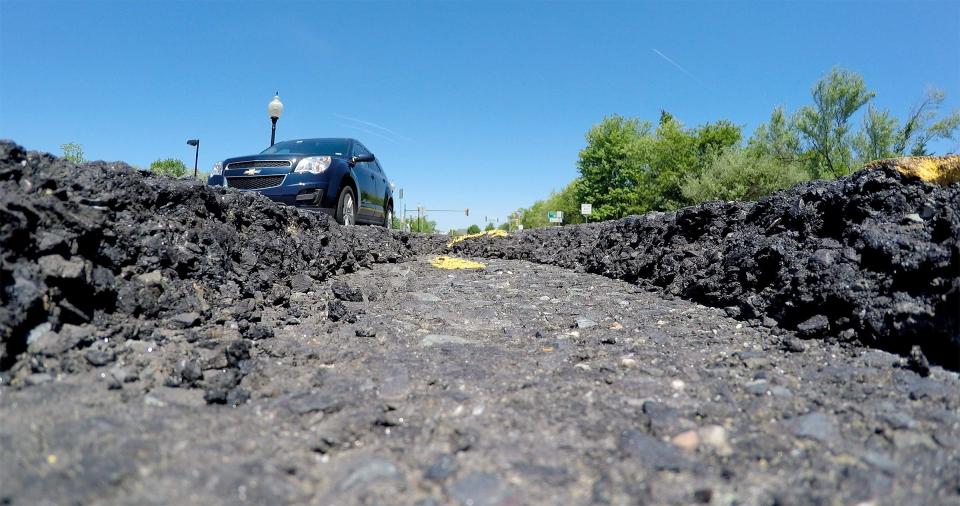Can you file a claim if a NJ monster pothole wrecks your car?
Ah, spring. The birds, the flowers. …
The potholes.
According to AAA, "potholes form when moisture collects in small holes and cracks in the road surface. As temperatures rise and fall, the moisture expands and contracts due to freezing and thawing. This breaks up the pavement and, combined with the weight of passing cars, eventually results in a pothole."
That makes springtime, following the winter snow and ice, prime time to run into potholes on roads in New Jersey.
So what happens when you hear that sickening thud and discover you have a flat tire — or worse?
Watch the roads: Check out the big road projects planned for Monmouth and Ocean counties through the 2020s
New Jersey pothole damage claims
According to the state, when considering filing a claim for damage, you'll need to determine who the road belongs to first.
It could be a local, county, state highway or toll road.

If it's local or county, the state says you should call the municipality or county, or visit their website for specific information.
If it's the Garden State Parkway or the New Jersey Turnpike, visit state.nj.us/turnpike/maintenance-issue.html or call 732-750-5300.
If it's the Atlantic City Expressway, issues are handled by the South Jersey Transportation Authority. Visit sjta.com or call 609-965-6060.
'Until it affects you': Wheelchair users still battle to make NJ more accessible
If you determine that the road is owned by the state, the registered owner of the damaged vehicle will need to fill out a Property Damage Claim - Short Form, located through NJ.gov.
But, the state says you'll need to deal with your insurance company first. They ask that you settle with your "physical damage insurance carrier" before submitting a claim. You then can file a claim for your deductible, or file one if you do not have physical damage coverage. You'll also need to determine if you have any auto club or tire warranty coverage first.
A claim must be filed within 90 days of the date of the accident, and include an estimate for the repair costs and/or a receipt showing payment for repairs made; the specific location where the incident occurred (exit, mile post, landmarks, etc.); a copy of a police report if one was filed; and the Declaration page of your car insurance policy.
The state says photos of the pothole are not necessary, and that you should allow three to six months for your claim to be resolved.
It notes that payment is not guaranteed. Factors that play into that include whether you have insurance that will cover the damage (if so, any insurance payments will be deducted from your claim); as well as whether officials had knowledge of the pothole and time to fix it prior to your incident.
How to avoid pothole damage
That said, avoiding pothole damage in the first place is best.
AAA offers the following tips to avoid issues:
Inspect tires: The tire is the most important cushion between a car and a pothole. Make sure tires have enough tread and are properly inflated. When checking tire pressures, ensure they are inflated to the manufacturer’s recommended levels, which can be found in the owner’s manual or on a sticker on the driver’s door jamb.
Inspect suspension: Make certain struts and shock absorbers are in good condition. Changes in vehicle handling, excessive vibration or uneven tire wear can indicate bad shocks or struts. Have the suspension inspected by a certified technician if you suspect problems.
Look ahead: Make a point of checking the road ahead for potholes. An alert driver may have time to avoid potholes, so it’s important to stay focused on the road and not any distractions inside or outside the vehicle. Before swerving to avoid a pothole, check surrounding traffic to ensure this will not cause a collision or endanger nearby pedestrians or cyclists.
Slow down: If a pothole cannot be avoided, reduce speed safely, being sure to check the rear view mirror before any abrupt braking. Hitting a pothole at higher speeds greatly increases the chance of damage to tires, wheels and suspension components.
Beware of puddles: A puddle of water can disguise a deep pothole. Use care when driving through puddles and treat them as though they may be hiding potholes.
Check alignment: Hitting a pothole can knock a car’s wheels out of alignment and affect the steering. If a vehicle pulls to the left or right, have the wheel alignment checked by a qualified technician.
Recognize noises/vibrations: A hard pothole impact can dislodge wheel weights, damage a tire or wheel, and bend or even break suspension components. Any new or unusual noises or vibrations that appear after hitting a pothole should be inspected immediately by a certified technician.
This article originally appeared on Asbury Park Press: It's pothole season in New Jersey. How to file a claim for damage

